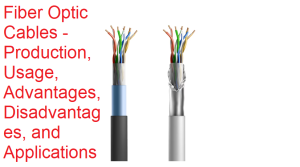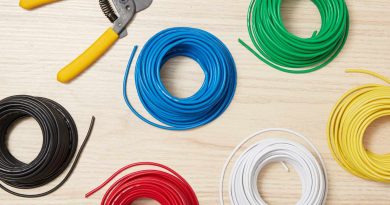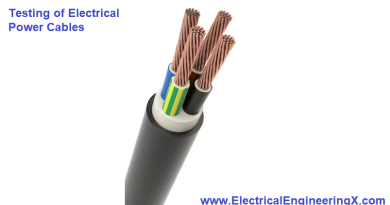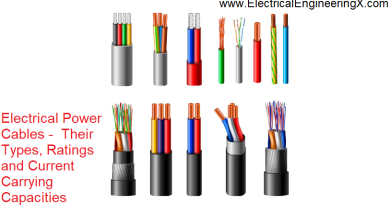Fiber Optic Cables – Production, Usage, Advantages, Disadvantages, and Applications
What are Fiber Optic Cables? Production, Usage, Advantages, Disadvantages, and Applications
Introduction
Fiber optic cables are the medium of choice for high-speed, long-distance telecommunications and networking, allowing the transmission of huge amounts of data over great distances using light pulses. Let’s explore what fiber optic cables are, how they work, production methods, types, parts, operating principles, key benefits and disadvantages, and significant applications of fiber optic cables.
What are Fiber Optic Cables?
Fiber optic cables are ultra-thin flexible cables containing one or more glass or plastic fibers, capable of transmitting data over long distances utilizing light pulses passing along the fiber core using the principle of total internal reflection. They have almost completely replaced copper wire communications.

How Fiber Optics Work
Fiber optics use light to carry information over distances. They work by guiding light pulses transmitted by a light-emitting diode or laser along thin glass or plastic fibers utilizing the physics of refraction and reflection.
Total Internal Reflection
This principle enables the light pulses to reflect within the core and be guided along the fiber with minimal loss in intensity over long distances.
Now, let’s examine the production process for making fiber optic cables.
Production of Fiber Optic Cables
Glass Preparation
High-purity silicon dioxide and germanium-doped glass are made into rod preforms using chemical vapor deposition, molten core processes, etc.
Preform Fabrication
The preforms are assembled and fused into glass rods containing the fiber core and cladding layers with desired refractive index profiles.
Drawing Process
The preform rod is precisely drawn into a thin glass fiber, maintaining the core-cladding arrangement by heating in a furnace.
Coating and Cabling
The drawn glass fiber is coated with protective polymer layers for strength. Multiple fibers are twisted into a protective jacket to form the cable.
There are different types of optical fibers:
Types of Fiber Optic Cables
Single-Mode vs. Multi-Mode
Single-mode have small core diameters that allow one propagation path, while multi-mode fibers have larger diameters, allowing multiple optical ways.
Step-Index vs Graded-Index
Step-index fibers have uniform refractive index across the core and cladding. Graded-index fibers have continuously varying refractive index distribution.
Plastic vs. Glass Fiber
Plastic polymer optical fibers are cheaper but have higher attenuation. Glass fibers have lower losses, enabling longer distances.
Key components make up a fiber optic cable:
Parts of a Fiber Optic Cable
Core
Thin glass center of the fiber where light travels, typically 5-100 microns in diameter.
Cladding
Surrounds the core, with a lower refractive index to guide light in the core.
Coating
One or more coatings of plastic like acrylate for protection and strengthening the fiber.
Jacket
Outer plastic covering that bundles fibers and provides environmental and mechanical protection.
Strength Members
Aramid yarn or glass-reinforced plastic rods are added for tensile strength and stretch resistance.
Understanding the working allows for utilizing fiber optic capabilities:
Working Principle of Fiber Optics
Light Propagation
Light rays entering the fiber core at low angles undergo total internal reflection without leaking out through the cladding.
Minimizing Attenuation
The index profile’s fiber materials and special shaping help minimize attenuation or signal loss over distance.
Digital Transmission
Light waves are modulated to encode digital information using binary on-off keying or complex modulation formats.
Photoelectric Conversion
Photodetectors like photodiodes convert the transmitted optical signals back into electronic signals.
Key benefits arise from using fiber optic cables:
Advantages of Fiber Optic Cables
High Bandwidth
Huge transmission bandwidths allow the sending of enormous amounts of data.
Low Attenuation Loss
Signals can be transmitted over KMS without repeaters, enabling long-distance communication.
Immunity from Interference
Fiber optics are immune to electromagnetic interference from external sources.
Long Distance Signal Transmission
Optical transmission using fiber achieves distances of hundreds of kilometers, enabling global networks.
Compact Size and Weight
Thin, flexible cables take much less space and weight compared to copper cables.
There are also some limitations of fiber optic cables:
Disadvantages of Fiber Optics
High Installation Costs
Fiber optic infrastructure requires high initial investments for installation and splicing equipment.
Fragility and Bending Sensitivity
Fibers are fragile and can break when bent excessively. Cabling needs to allow for this.
Signal Attenuation
Light signals still attenuate over distance, necessitating amplification and regeneration.
Upgrade Challenges
Upgrading core networks to newer fiber types can be logistically challenging.
Major application areas that benefit from fiber optic cables:
Applications of Fiber Optic Cables
Telecommunications
Extensively used in telephony, internet, cable TV, and private data networks, enabling high-speed broadband global connectivity.
Computer Networks
Used for connections between servers, switches, routers, etc. in high-speed LANs and WANs.
Medical Imaging
Fiber optics enable high-resolution interference endoscopy and visualization in surgery, dentistry, etc.
Military and Aerospace
Used in guidance, communications, sensing, and imaging applications needing electromagnetic noise immunity.
Future Trends in Fiber Optic Technology
The future holds exciting possibilities for fiber optic technology.
Increased Bandwidth
Continual advancements will lead to even higher data transmission speeds and greater bandwidth.
Integration with 5G
Fiber optic technology will play a pivotal role in deploying 5G networks, enabling faster and more reliable connections.
Conclusion
Summary
Fiber optic cables have revolutionized high-speed, long-distance communication and networking by utilizing light to carry enormous amounts of data quickly and reliably. Careful glass engineering enables transmitting signals over kilometers without distortion using the principle of total internal reflection. With advantages like huge bandwidth, low attenuation, and noise immunity, fiber optics are vital for telecommunications despite higher installation costs.
FAQs
- How do fiber optic cables work?
They use a total internal reflection of light pulses within an optical fiber core to guide low-loss signals over long distances.
- What are the main components of fiber optic cables?
Key components are glass core and cladding, protective coating, outer jacket, and strength members.
- What are the different types of optical fibers?
Single/multi-mode fibers, step/graded-index fibers, and plastic/glass core fibers are significant types.
- What are the advantages of fiber optic cables?
Benefits include huge bandwidth, low attenuation, immunity from electrical interference, long-range transmission and small size.
- What are some limitations of fiber optics?
Limitations include high installation costs, fragility issues, eventual signal attenuation, and upgrade difficulties.
- How are fiber optic cables produced?
Fabrication involves producing, and precisely drawing fiber, coating, and cabling multiple fibers within protective jackets.
- Where are fiber optics used?
Applications include telecommunications, computer networks, medical imaging, military systems, and instrumentation needing EMI immunity.
- How does bending affect fiber optic cables?
Excessive bending beyond a minimum radius can break the fiber or increase attenuation losses from light escaping the core.
- What enables long-distance optical transmission?
Special fiber designs, ultra-pure glass, and optimized numerical apertures all help minimize attenuation losses as signals propagate.
- How is light modulated in fiber optics?
Light-emitting diodes modulate injected light to encode binary or digital data reconstructed by photodetectors.
MCQs
- What is the core material in fiber optic cables?
- The core material in fiber optic cables is typically silica glass or plastic.
- How does fiber optic technology work?
- Fiber optic technology transmits data as light pulses through thin glass or plastic fibers.
- Are fiber optic cables the future of internet connectivity?
- Yes, fiber optic cables are crucial for high-speed internet connectivity and are expected to play a significant role in the future.
- Can fiber optic cables be used for underwater communication?
- Yes, fiber optic cables are used for underwater communication due to their efficiency and immunity to electromagnetic interference.
- What are the key differences between single-mode and multi-mode fiber optic cables?
- Single-mode fiber is designed for long-distance communication, while multi-mode fiber is suitable for shorter distances.
- Are fiber optic cables environmentally friendly?
- Fiber optic cables are considered more environmentally friendly than traditional copper cables due to their lower energy consumption.
- Are there any health concerns related to fiber optic cables?
- No, fiber optic cables do not emit harmful radiation and are safe for human health.
- How do you install fiber optic cables?
- Installing fiber optic cables requires specialized knowledge and equipment to ensure proper installation and signal quality.
- What are the cost considerations when choosing fiber optic cables?
- Fiber optic cable costs include installation, materials, and maintenance, which can be higher than traditional cables.
- What are some emerging applications of fiber optic technology?
- Emerging applications include 5G networks, smart cities, and high-speed data transmission in remote areas.




